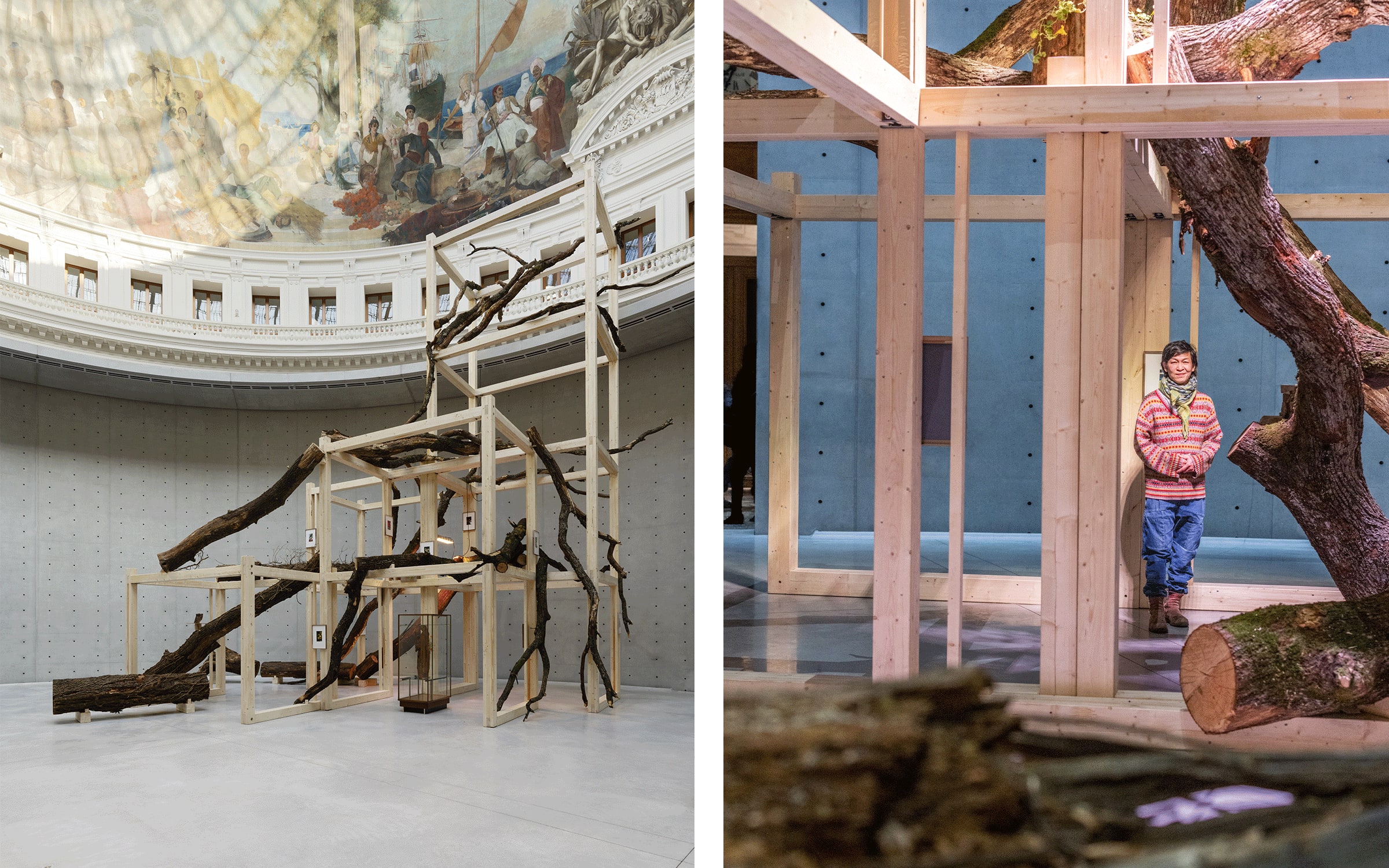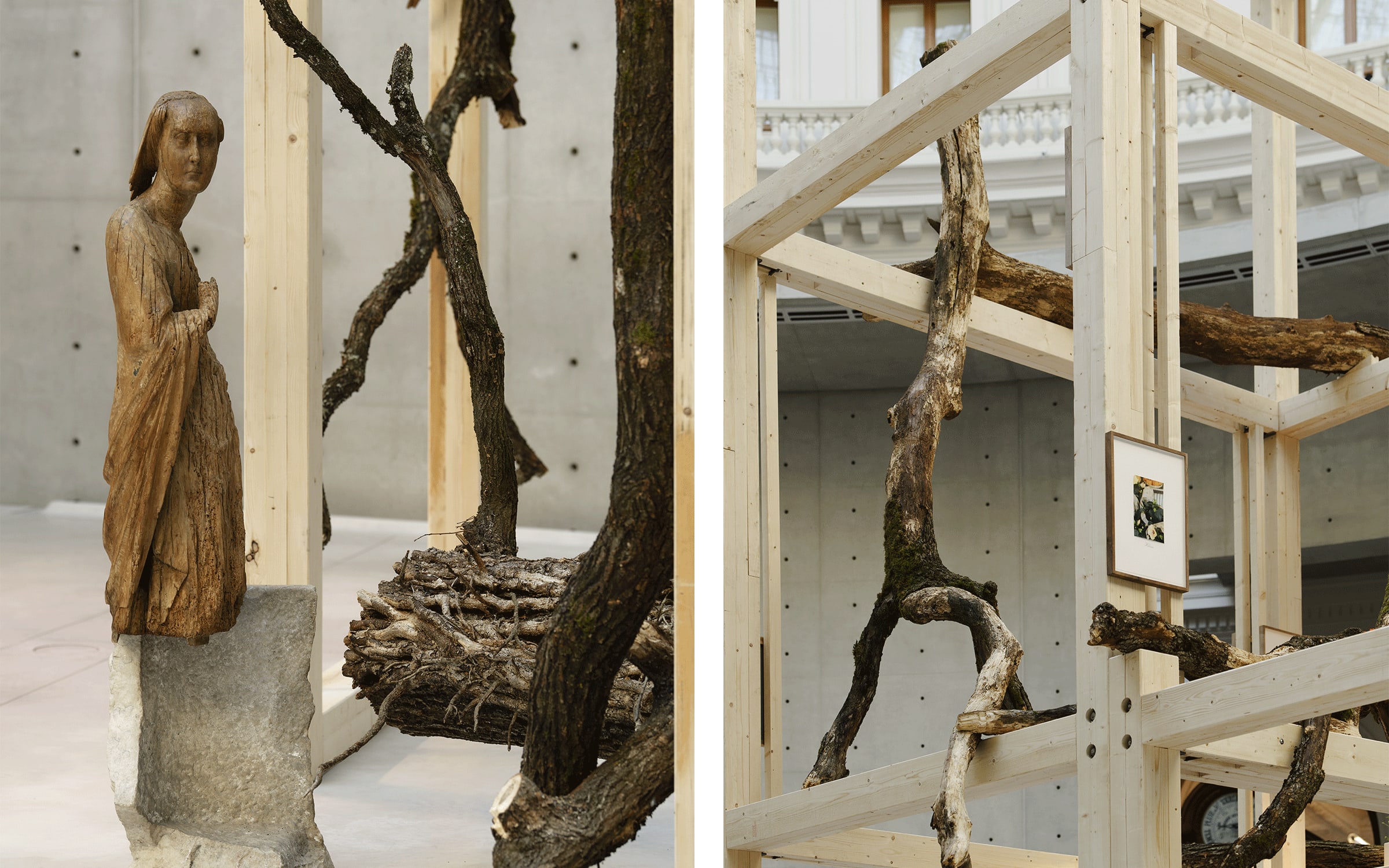In collaboration with Numéro art
In the middle of the rotunda, under the impressive glass roof at the Bourse de Commerce in Paris, weatherworn tree trunks are soaring into the sky in a final, desperate bid for survival. Installed by the artist Danh Vo as a monumental bouquet fitting the dimensions of the space, in their death these trees unfold through the most unexpected mutations. They bloom – their flowers, which appear as scattered, colorful, and seductive touches throughout the installation are photographs taken and arranged by the artist.
Death as a fertile breeding ground – the blossoming of the corpse foreshadows other surprises, such as the presence of previous works by the artist. These are mainly wooden sculptures that curl up or join with the trunks like a myriad of grafted branches. This bouquet of forms is paradoxical, both deadly and fragile, supported by hope and resilience – and more prosaically by timber structures holding these martyred trunks. ‘An experience in which beauty and threat are intertwined in the same space,’ according to curator Caroline Bourgeois.

In a way, the artwork stands as a philosophical manifesto for the new direction taken by Vo in his work. For some years now, he has been living in a farm-studio in Güldenhof, Germany. Amid an orchard, meadows, gardens, and a greenhouse, he works on reuniting the different meanings of the word ‘culture.’ The care taken in the development of nature, symbolized by the garden and the orchard, echoes the care taken of the wounded nature represented by the trees in this exhibition.
He also expands his knowledge of nature, meticulously photographing the flowers in his garden, handwriting captions of their scientific names. The series of photographs of flowers at the Bourse de Commerce derives from this, but this time the pictures were taken at a florist. In contrast with the traditional dichotomy in the West, Vo thwarts the opposition between nature and culture. Art, as the ultimate cultural object, is cradled by nature. It was in Stechlin too that the artist first began to use historical sculptures – often wooden elements from churches – installing them in the garden where they could reconnect with nature.
Nothing is either completely natural or completely cultural at the Bourse de Commerce. The tree trunks have been treated before going on display and have been installed according to the artist’s choices. The structures that support them, the artworks that seem to grow out of them, and even the frames for the photographs, are made of the same wood, even if its origin differs (to which I will return later). Nature and culture thus shape each other in an infinite cycle of life and death.
The environment Vo unfolds also reverses the horizontality of classical landscape painting. The cluster of trees looks disorganized, moving in all directions. People can walk through it without ever being able to take it all in from any one viewpoint. Although the timbers are a human-made structure, they seem only to be supporting props, devoid of any intent to impose their own power. The decentering is complete. If nature is being domesticated, it is because we share the same home, the same domus.

Vo fled Vietnam by boat with his Catholic refugee parents in 1979. This key event has imbued his work with ideas of displacement and decentering, as well as a clear understanding of the complex strata of history – all evident in his major exhibition at the Solomon R. Guggenheim Museum in New York in 2018. Since then, Vo has been developing his pieces from fragments that he assembles in order to manifest relationships rather than to judge them. An approach that Bourgeois defines as ‘make do: make do with what we carry with us and what we find, make do with all the contradictions surrounding us and within us.’
Vo thus does make do with these tree trunks which were struck by lightning in a French forest, as well as with chance happenings and his own story. The same applies to the wood used in the timber structures and frames in the exhibition. A few years ago, Vo discovered that the son of Robert McNamara, US Secretary of Defense under President John F. Kennedy and mastermind behind the Vietnam War, owned a sustainable farm in California. He decided to buy some black walnut from him and, back in 2012, he also bought some of McNamara’s possessions at auction in order to include them in his exhibitions. Geopolitical and personal histories were therefore intertwined in a double displacement of the political to the artistic, and the reappropriation of objects. For Vo objects are reactivated, dissected, and reassembled to reveal their full dimensions beyond just those of their function and aesthetic, all the time without dissociating family from politics, or story from history.
This article is part of a yearlong collaboration between Paris+ par Art Basel and Numéro art. Click here to read the original article.
Danh Vo is represented by Galerie Chantal Crousel (Paris), Marian Goodman Gallery (New York, Paris, London) et Xavier Hufkens (Brussels).
‘Tropeaolum’
Until April 24, 2023
Bourse de Commerce - Pinault Collection, Paris
English translation: Emma Naroumbo Armaing.
Caption for full-bleed images: Danh Vo, Tropeaolum, 2023. Courtesy of Bourse de Commerce – Pinault Collection.
Published on February 28, 2023.
See also Danh Vō's Premiere Artist Talk, as part of the Conversations program at Art Basel 2015.